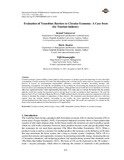| dc.contributor.author | Kazancoglu, Y. | |
| dc.contributor.author | Vatansever, K. | |
| dc.contributor.author | Akarsu, H. | |
| dc.date.accessioned | 2021-06-29T07:12:40Z | |
| dc.date.available | 2021-06-29T07:12:40Z | |
| dc.date.issued | 2021-06 | |
| dc.identifier.issn | 2455-7749 | |
| dc.identifier.uri | https://apps.webofknowledge.com/InboundService.do?product=WOS&Func=Frame&DestFail=http%3A%2F%2Fwww.webofknowledge.com&SrcApp=search&SrcAuth=Alerting&SID=C2KdONul62VtWYhvn1d&customersID=Alerting&mode=FullRecord&IsProductCode=Yes&AlertId=fc1c72a7-b080-4d60-92a3-edbe4aa40157&Init=Yes&action=retrieve&UT=WOS%3A000654044900007 | en_US |
| dc.identifier.uri | https://dspace.yasar.edu.tr/xmlui/handle/20.500.12742/11247 | |
| dc.description.abstract | Current economic system exhibits a linear path by using resources to produce goods and disposing of waste after their consumption. Circular economy (CE) turns this linear pattern into a circular one by using waste as a resource for another process. It focuses on environmental responsibility, efficiency, renewable resources, preventing wastage, and, minimizing consumption. CE helps the sustainability of the economy by restructuring the production processes to use fewer resources and extending the lifetime of the products. Although there are powerful drivers for transition to CE firms often face significant barriers while implementing their plans. This study aims to evaluate the barriers that the tourism industry would face during the transition process and put them in order according to their importance. We used the Interval Type-2 Fuzzy Analytical Hierarchy Process (FAHP) method which is based on a pairwise comparison of relevant criteria to calculate the weights of importance of these barriers. We conducted semi-structured interviews with four experts from the tourism industry. According to our results, the most important barrier is organizational structure/infrastructure that creates inconvenience with the supply chain. The results are expected to be a guide for the firms in the tourism industry for their transition to CE applications. | en_US |
| dc.language.iso | English | en_US |
| dc.publisher | INT JOURNAL MATHEMATICAL ENGINEERING & MANAGEMENT SCIENCES-IJMEMS | en_US |
| dc.rights | info:eu-repo/semantics/openAccess | en_US |
| dc.subject | Circular economy | en_US |
| dc.subject | Interval type-2 fuzzy AHP | en_US |
| dc.subject | Sustainable tourism | en_US |
| dc.subject | Barriers to circular economy | en_US |
| dc.title | Evaluation of Transition Barriers to Circular Economy: A Case from the Tourism Industry | en_US |
| dc.type | Article | en_US |
| dc.relation.journal | INT JOURNAL MATHEMATICAL ENGINEERING & MANAGEMENT SCIENCES-IJMEMS | en_US |
| dc.identifier.doi | 10.33889/IJMEMS.2021.6.3.049 | en_US |
| dc.contributor.department | Department of International Logistics Management | en_US |
| dc.identifier.issue | 6 | en_US |
| dc.identifier.volume | 3 | en_US |
| dc.contributor.yasarauthor | 0000-0001-9199-671X: Yiğit Kazançoğlu | en_US |















